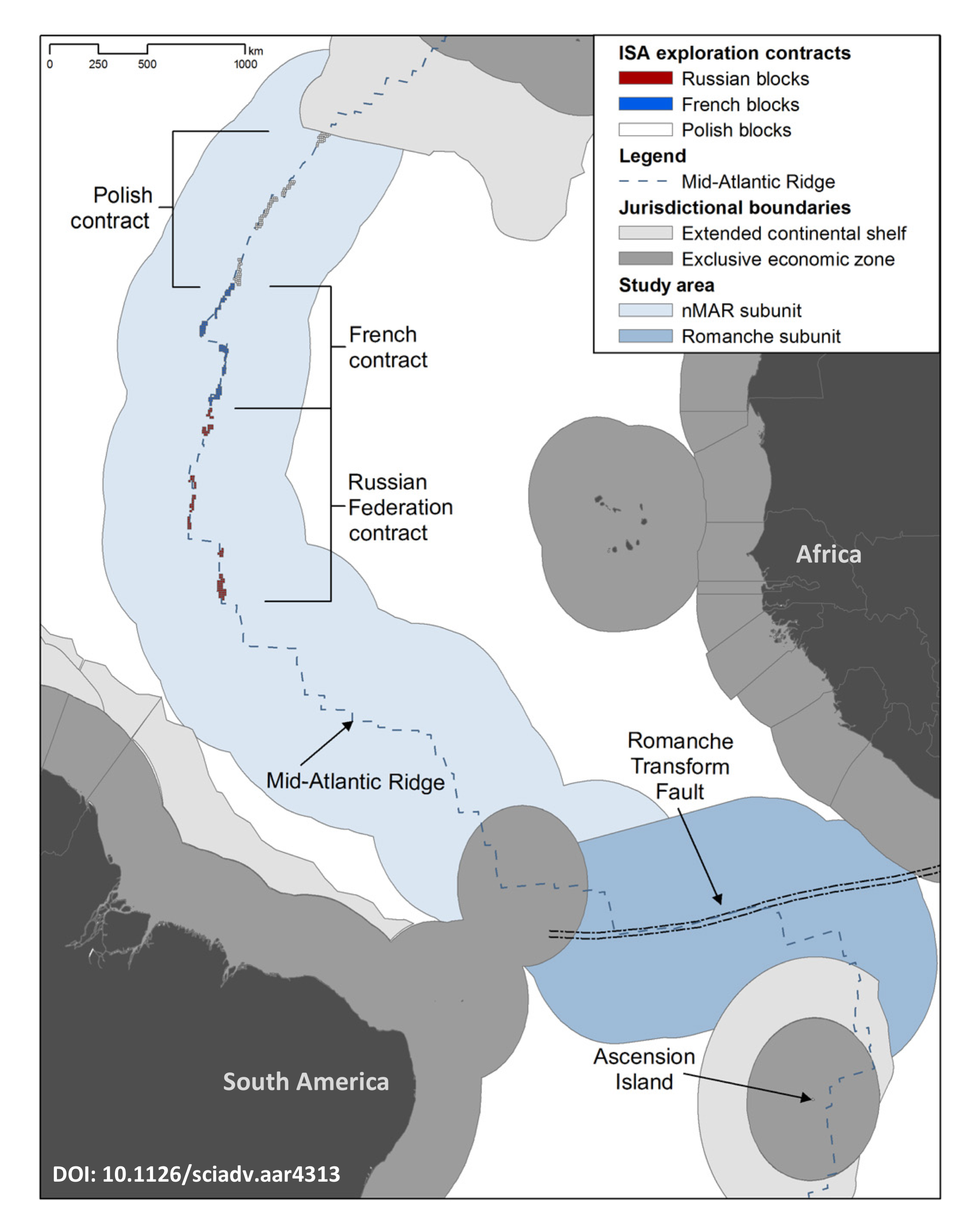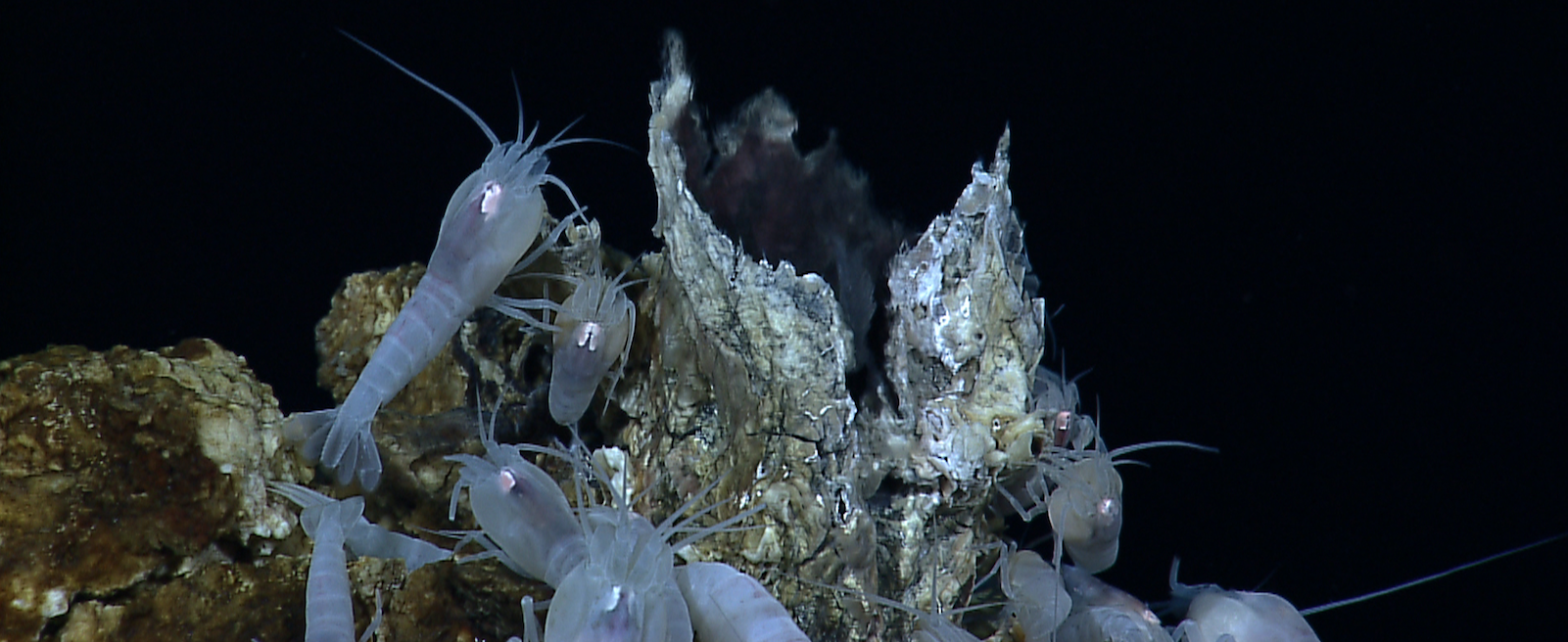Lead: Cindy Lee Van Dover, Duke University

Mid-ocean ridges – the zipper-like boundary between tectonic plates in several of the world’s oceans – are home to hydrothermal vents: patchy areas of the seafloor where mineral-rich fluids are expelled into the water column. Fuelled by this cocktail of chemicals, diverse communities of tube worms, clams, snails and shrimp thrive around the hydrothermal vent chimneys. Relative to most of the surrounding deep sea, hydrothermal vent ecosystems are biologically more productive and support endemic invertebrate and fish taxa with biochemical, physiological and ecological adaptations to the vent environment.
The unique physical and chemical conditions at deep-sea hydrothermal vents have led to the formation of mineral deposits that have become the focus of commercial interest. The emerging deep-sea mining industry has the potential to generate a range of environmental disturbances that would have serious negative impacts on the health of hydrothermal vent fauna and their habitats, disrupt natural connections between vent systems, and impact other marine life such as fish and migratory species. The consequences of mining activity on such a fragile habitat and the broader ramifications for the deep-sea ecosystem are only now beginning to be understood.

GOBI’s hydrothermal vents team set out to significantly increase our understanding the risks of deep-sea mining activity to active hydrothermal vents, and the nature of the precautionary measures necessary to protect them. The outcomes of this work have direct application to the International Seabed Authority (ISA), the UN- affiliated body with the mandate to ensure the effective protection of the marine environment from harmful effects that may arise from deep-seabed related activities in areas of the seabed beyond national jurisdiction. Throughout the duration of GOBI’s IKI grant, the ISA has been developing regional environmental management plans for mid-ocean ridge areas in the Atlantic and Indian oceans, as well as a set of draft regulations to manage future deep-sea mining activities.
Quantitative risk assessment for deep-sea mining is challenging given the data-poor state of knowledge of deep-sea ecosystem structure, process, and vulnerability. GOBI scientists carried out an extensive survey of experts to rank risk sources and perceived vulnerabilities of habitats associated with different types of deep-sea mineral deposit. The outcomes (Washburn et al. 2019) underscored the need for risk assessments to progress from expert opinion with low certainty to data-rich and ecosystem-relevant scientific research assessments to yield much higher certainty. Scientific experts who were polled identified benthic habitats associated with seabed minerals as most vulnerable to habitat removal, with a high degree of certainty. Resource-associated benthic and pelagic habitats were also perceived to be at risk from sediment plumes generated during mining activities, although there was not always consensus regarding vulnerabilities to specific risk sources from different types of plumes. Even for risk sources where habitat vulnerability measures were low, high uncertainties suggest that these risks cannot yet be dismissed.
A precautionary approach to protecting biodiversity on mid-ocean ridges is to design and implement a network of areas protected from the effects of mining, as highlighted by other research (Wedding et al. 2019). Such a network should capture representative populations of vent endemic fauna within regions of connectivity and across persistent barriers, but determining where such connectivity and barriers exist is challenging. In collaboration with genetic and hydrographic experts, the GOBI team undertook biophysical connectivity modelling among fragmented hydrothermal vent habitats along the northern Mid-Atlantic Ridge to better understand how and on what scale larvae from hydrothermal vent fauna can disperse (i.e., connecting different vent populations), and where breaks in or barriers to that dispersal likely occur (Yearsley et al. 2020). This knowledge is critical to understanding the impacts that an activity such as deep-sea mining might have on the natural system, and to inform the design and implementation of a network of protected areas. Results showed that while vent larvae may disperse significant distances from a vent site, numerous natural barriers to dispersal are an important factor in determining genetic diversity in vent populations along the ridge. This work highlighted that there is a need to protect the pelagic habitat of the dispersive larval stages that are essential for maintenance of the fragmented benthic populations, as well as the vent sites themselves.
Large seafloor areas have been approved for exploration for seafloor mineral deposits by the ISA, creating an urgent need for regional environmental management plans. Networks of areas where mining and mining impacts are prohibited are key elements of these plans. The GOBI team developed options for marine reserve design on the northern Mid-Atlantic Ridge (Dunn et al. 2018), specifically adapted to the distinctive biophysical environments (i.e., flanks, axial valleys, faults, hydrothermal vents, etc). The design included future climate-proofing considerations and a suite of metrics to measure network performance against conservation targets and network design criteria.
Ultimately, justification for protecting all hydrothermal vent ecosystems (Van Dover et al. 2018) was put forward by the international scientific community at a series of workshops relating to environmental management of seafloor massive sulphide mining. Recommendations were made to the ISA to inform the development of a Regional Environmental Management Plan (REMP) for the northern portion of the Mid-Atlantic Ridge, with the principles also being relevant for the REMP being developed for the mid-ocean ridge in the south-west Indian Ocean. To further support the case for protection of active vents, a detailed characterisation of known vent sites on the northern Mid-Atlantic Ridge within ISA jurisdiction was carried out using criteria already established by competent international authorities (Gollner et al. 2021). All known vent fields in the region met multiple criteria for vulnerability, sensitivity, and ecological or biological significance and need protection. Further assessment and comparison of the specific measures for the 155 managed active hydrothermal vents (Menini et al. 2023) revealed that the current conservation of active hydrothermal vent ecosystems remains fragmented and discordant across jurisdictions and biogeographical provinces, resulting in overall insufficient protection, especially in ABNJ.

Impact and relevance
Results from this work continue to inform discussions at the ISA on the design and location of management measures for mid-ocean ridge environments that become targets for deep- sea mining activity. The need for robust scientific information to underpin decision-making, and inclusion of scientific experts in discussions on spatial management strategies for deep ocean environments is also brought into sharp focus and will relate to similar exercises in other ocean basins.
Key publications from this work
Dunn, DC, Van Dover CL, Etter RJ, Smith CR, Levin LA, Morato T, Colaco A, Dale AC, Gebruk AV, Gjerde KM, Halpin PN, Howell KL, Johnson D, Perez JAA, Ribeiro MC, Stukas H, and Weaver P (2018) A strategy for the conservation of biodiversity on mid-ocean ridges from deep-sea mining. Science Advances 4; doi:10.1126/sciadv.aar4313
Gollner S, Colaço A, Gebruk A, Halpin PN, Higgs N, Menini E, Mestre NC, Qian PY, Sarrazin J, Szafranski K, Van Dover CL (2021) Application of scientific criteria for identifying hydrothermal ecosystems in need of protection. Marine Policy 132; doi:10.1016/j.marpol.2021.104641
Menini E, Van Dover C (2019) An atlas of protected hydrothermal vents. Marine Policy 108; doi: 10.1016/j.marpol.2019.103654
Menini E, Calado H, Danovaro R, Manea E & Halpin PN (2023) Towards a global strategy for the conservation of deep-sea active hydrothermal vents. npj Ocean Sustainability; doi: 10.1038/s44183-023-00029-3
Niner HJ, Ardron JA, Escobar EG, Gianni M, Jaeckel A, Jones DOB, Levin LA, Smith CR, Thiele T, Turner PJ, Van Dover CL, Watling L and Gjerde KM (2018) Deep-sea mining with no net loss of biodiversity – an impossible aim. Frontiers in Marine Science 5; doi: 10.3389/ fmars.2018.00053
Van Dover C (2019) Inactive sulfide ecosystems in the deep sea: A review. Frontiers in Marine Science 6; doi: 10.3389/fmars.2019.00461
Van Dover C, Ardron J, Escobar E, Gianni M, Gjerde K, Jaeckel AB, Jones D, Levin L, Niner H, Pendleton L, Smith C, Thiele T, Turner P, Watling LE, Weaver P (2017) Biodiversity loss from deep-sea mining. Nature Geoscience 10; doi: 10.1038/ngeo2983
Van Dover CL, Arnaud-Haond S, Gianni M, Helmreich M, Huber JA, Jaeckel AL, Metaxas A, Pendleton LH, Petersen S, Ramirez-Llodra E, Steinberg PE, Tunnicliffe V, Yamamoto H (2018) Scientific rationale and international obligations for protection of active hydrothermal vent ecosystems from deep-sea mining. Marine Policy 90; doi: 10.1016/j. marpol.2018.01.020
Van Dover CL, Colaço A, Collins PC, et al. (2020) Research is needed to inform environmental management of hydrothermally inactive and extinct polymetallic sulfide (PMS) deposits. Marine Policy 121; doi: 10.1016/j.marpol.2020.104183
Van Dover CL and Smith HW (2020) Extinct Hot Springs: A Sustainable Source for Deep-Sea Mining? ECO Deep Sea
Washburn T, Turner P, Durden J, Jones D, Weaver P, Van Dover C (2019) Ecological risk assessment for deep-sea mining. Ocean and Coastal Management 176; doi: 10.1016/j.ocecoaman.2019.04.014
Yearsley JM, Salmanidou DM, Carlsson J, Burns D, Van Dover CL (2020) Biophysical models of persistent connectivity and barriers on the northern Mid-Atlantic Ridge. Deep Sea Research Part II: Topical Studies in Oceanography 180; doi: 10.1016/j.dsr2.2020.104819

